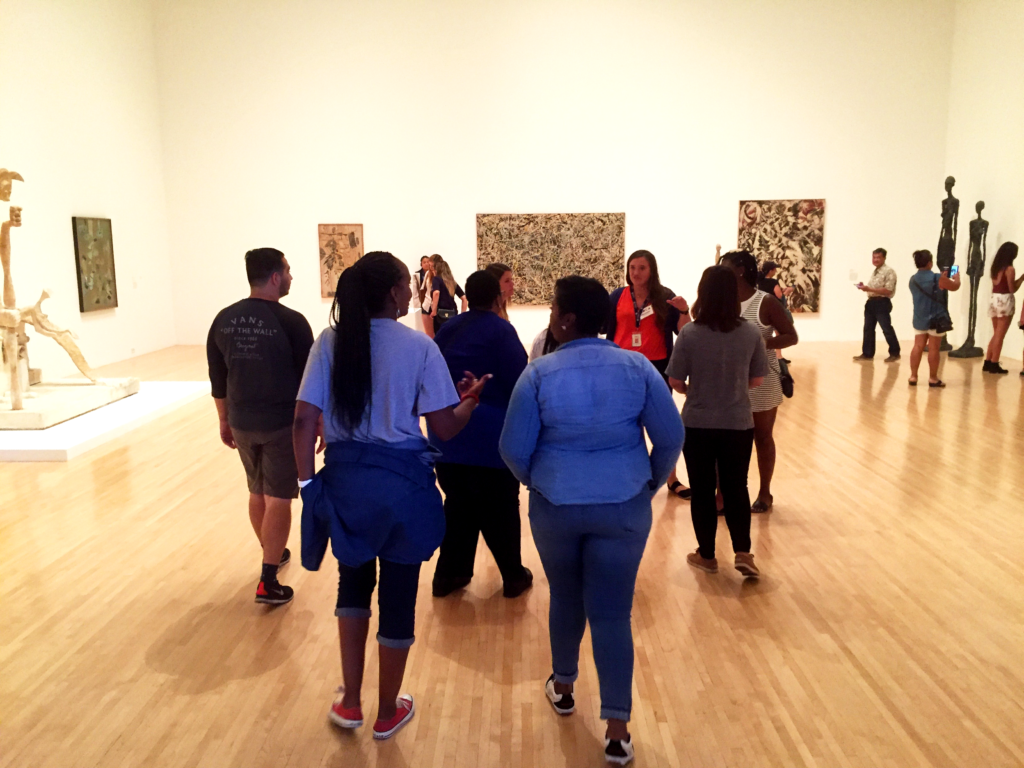By Cathryn Deering
What is VTS?
This year at Florence Griffith Joyner Elementary School (FloJo), we have decided that the school-wide, arts-based strategy we’re implementing will be Visual Thinking Strategies (VTS). VTS is a method that teachers can use to lead inquiry-based discussions around different art images.
In this process, students are asked to look carefully at a work of art without knowing the name of the image or the artist. They discuss their observations and give evidence from the image to support their observations. In using the three VTS questions, teachers are able to facilitate thought-provoking conversations in a neutral way that promotes critical thinking and creative problem solving.

VTS Training at MOCA: Highlights
The most powerful skill I learned during the FloJo team’s recent VTS training at the Museum of Contemporary Art, Los Angeles (MOCA) was the ability to sit with ambiguity. I think that this is one of the toughest things to deal with in life! VTS not only teaches you how to be comfortable with sitting in ambiguity, but also how to create your own solution for something instead of jumping right to a conclusion or trying to find an exact, immediate answer.
During our initial VTS training at MOCA, Liz Harvey, our trainer, walked us through the VTS process by first demonstrating on us and then breaking us into small groups to practice the process with each other. My biggest challenge was wanting to know immediately what the picture was and the meaning behind it. But, alas, I knew that was a big no-no in the world of VTS. Letting go of control is never easy for a teacher! I have to admit, when we practiced VTS in the gallery, I kept feeling my eyes wander over to the placard next to the image to find out any little bit of information I could about the image; I soon realized that I wasn’t the only one. The controlling teacher started coming out in some of my colleagues as well. When this started to happen, I realized why the name of the image or artist isn’t revealed in VTS. By not knowing anything about the image, I felt how important it was to be in the moment and pay close attention to the details of the image; I had to assign my own meaning to the image and have clear evidence to support my conclusions. After hearing various answers from my colleagues, I changed the way that I perceived the meaning of the image multiple times — they all had such powerful observations and valid reasons to support them. When I was focusing on all of the minor details, like the name of the artist and the name of the image, I lost interest and was ready to move on. All of the powerful details became insignificant because I thought that I had my answer and didn’t need to put any further brainpower into it. The image became something that I just looked at, not something that had meaning. This translates so well into our students’ education. Now that we live in the world of Common Core, it is no longer about how much you can memorize — it is about how deeply you can understand something.
VTS at FloJo: How is your team planning to implement these strategies?
We are so fortunate as a Turnaround Arts: California partner school to receive VTS training. Our goal at FloJo is to have the whole school using the same VTS vocabulary and eventually implementing the strategy across all content areas. By November, our teachers will create an arts integrated unit that utilizes VTS as one of the main teaching strategies. VTS will provide ongoing coaching and support throughout this process!

Looking Ahead: What do you think FloJo will look like 6 months from now, 6 years!
As soon as our school community is consistent in implementing this strategy, we would love to train community members to use it as well. VTS is a strategy that is accessible to all, no matter your education or language level. Not only can parents use VTS to assist their children with their schoolwork, but they will be able to learn from their children as well.
A few years from now, we want to see our community of learners participating in a positive shift for Watts. VTS will help our students find meaning in what they do and be able to discover who they are as individuals. The skill of sitting comfortably in ambiguity and struggle, and how to figure out a solution, is one of many components that will make our children grow and succeed in life. This can give our children meaning and purpose in a society with inequitable systems that often take such things away from them. If VTS can lay the foundation for our learning community to think critically, to think with an open mind, to create a safe place to voice opinions, and to learn creative problem solving, then this will be one of the most powerful tools that we can arm our students with to reimagine and rebuild inequitable systems as systems that create a successful future.
